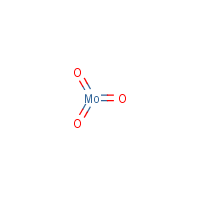Molybdenum trioxide
Agent Name
Molybdenum trioxide
Alternative Name
Molybdenum(VI) oxide
CAS Number
1313-27-5
Formula
Mo-O3
Major Category
Metals

Synonyms
Molybdenum(VI) oxide; Mo-1202T; Molybdena; Molybdenum oxide (MoO3); Molybdenum peroxide; Molybdenumperoxide; Molybdic acid anhydride; Molybdic anhydride; Molybdic oxide; Molybdic trioxide; Natural molybdite; [ChemIDplus]
Category
Metals, Inorganic Compounds
Description
White or slightly yellow to slightly bluish solid; [Merck Index] Light green odorless powder; Partially soluble in water (1.07 g/L at 18 deg C); [MSDSonline] A soluble compound; [ACGIH]
Sources/Uses
Used primarily in steel production as a corrosion inhibitor (~80-90%),then catalyst for refineries (~10%), then super alloys (~5%); [IARC Monograph 118] Used as a polymerization catalyst of olefins, a reagent in chemical analysis, a corrosion inhibitor, a catalyst in the petroleum industry, and an agricultural chemical; Also used to make molybdenum metal and alloys as well as ceramics, enamels, and pigments; [HSDB]
Comments
An eye, mucous membrane, and upper respiratory tract irritant; [HSDB] Serious health risk by ingestion or prolonged inhalation; [eChemPortal: ESIS] Carcinogenicity in man cannot be assessed conclusively because of insufficient data (Group 3B); [MAK] An irritant; [MSDSonline] See "Molybdenum."
Biomedical References
Exposure Assessment
TLV (ACGIH)
0.5 mg/m3, as Mo, respirable fraction
PEL (OSHA)
5 mg/m3, as Mo
IDLH (NIOSH)
1000 mg/m3, as Mo
Lethal Concentration
LC50 (rat) > 5,840 mg/m3/4h
Adverse Effects
IARC Carcinogen
Possible (2b)
Diseases, Processes, and Activities Linked to This Agent
Processes
Industrial Processes with risk of exposure:
Activities
Activities with risk of exposure: